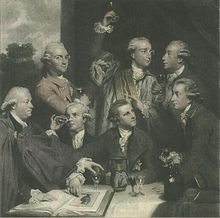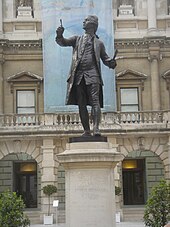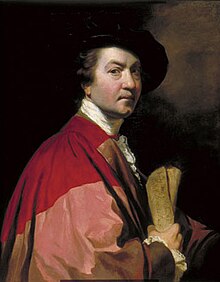Joshua Reynolds
Sir Joshua Reynolds , PRA FRSA (born July 16, 1723 in Plympton near Plymouth , County Devon , England , † February 23, 1792 in London ) was next to William Hogarth and Thomas Gainsborough the most famous and most influential English painter through his artistic and theoretical work of the 18th century . It becomes the " English school " of the 18./19. Century counted. In 1768 he became the first president of the newly formed Royal Academy of Arts .
Life
Early years
Reynolds was born the son of a clergyman and began an apprenticeship with the portrait painter Thomas Hudson in London when he was seventeen . Four years of apprenticeship had been agreed, but after two and a half years Reynolds left Hudson's workshop, having learned everything Hudson could teach him. In the following years he tried portrait painting in Plymouth .
On his trip to Italy from 1750 to 1752 he completed his artistic training. He was enthusiastic about the art of antiquity and the high renaissance , especially the works of Raphael and Michelangelo , but this did not prevent him from painting some funny parodies of their works, such as a parody of Raphael's School of Athens . But the Venetians also left their influence on Reynolds' works.
Turning to the "Grand Style" with its borrowings from great masters
Back in London, the influence of Italy in his works is unmistakable. From then on, Reynolds devoted himself to " Grand Style " and became an advocate of portrait and history painting that was based on the ideal of great art from bygone eras. With his method of "borrowing" he adopted actions, attitudes or gestures of other masters in his work. This was not a simple copy of the old masters, but a competition with them.

The ennoblement of English portrait painting
In the 18th century, portrait painting was mainly in demand in England , because nobles and wealthy business people wanted to see themselves represented in an idealized form on the walls of their rooms. In addition, even if one valued other types of painting, the English painters were not trusted to take historical pictures on a grand scale, but only to foreign artists, especially Italians and French. At that time the history painting represented the highest genre within painting. However, this genre was mainly bought by collectors in Italy, and in order to put English painting on a par with painting in other European countries, it was necessary to use English history painting, as only a few local artists, such as James Thornhill , used to make them more socially acceptable at the beginning of the 18th century . To achieve this, Reynolds approached the portrait of history. This approach meant an idealization and elevation of the portrayed, which was well received by the clients. Reynolds became the most popular portrait painter in London.
President of the Royal Academy of Arts (1768–1792)
When the Royal Academy of Arts was founded in 1768 , King George III stayed. who was not exactly a fan of Reynolds, given his popularity with the public, no choice but to name him president. And the following year Reynolds was knighted for his services. In the position of Academy President it was easier for him to achieve his goal of ennobling English painting.
In 1769 King George III raised it. as a Knight Bachelor in the nobility .
History painting
In 1773 he dared for the first time to exhibit a history painting , Ugolino and his sons in the Hunger Tower , in the Royal Academy in order to introduce the public to other genres besides portrait painting .
The Discourses on Art
His annually held discourses at the awards ceremony of the Royal Academy also served to enhance English art. On the one hand, he tried to create a tradition for English painting with the help of the doctrine " ut pictura poesis ", which compares painting with poetry, on the other hand he propagated history painting and the "grand style", which in his opinion was the only appropriate one Style for this genre. Thus, through his exhibited works and his discourses, he influenced the taste of collectors and art production.
The last few years
In 1781 he made a trip to Flanders and Holland, which also took him to some German cities, such as Aachen, Cologne and Düsseldorf. Here he was strongly influenced by Rubens ' art . He was enthusiastic about the application of paint and the informal presentation of his subjects. A more painterly style can now be seen in Reynolds' works and the portrayal in his paintings becomes more vibrant and dramatic.
In 1784 Reynolds was appointed court painter to the king. In 1789 he went blind and had to give up painting.
Rating

Reynolds has succeeded in giving English painting a tradition and in renewing the idle native history painting and making it acceptable to a broad public. With his academic discourses he was for a long time the sole authority within English art theory.
Reynolds has particularly distinguished himself as a portrait painter. He surpassed all earlier English painters in his fine feeling for forms and in his powerful presentation, and he also achieved a rare freshness in his coloring. But he lacked originality. As an eclectic , he tried to combine the virtues of Titian , Rubens , Rembrandt and Correggio , but in doing so he got into coloristic experiments that have spoiled many of his pictures. He succeeded particularly well in portraying the freshness of youth and the naive nature of children. From today's perspective, the execution of his history pictures are less successful, as they lack the lightness of the composition and the veracity of the representation. One of his best paintings is the death of Cardinal Beaufort and, of the greatest grace, his God of love, loosening the belt of beauty . His "Discourses" held by him as President of the Painting Academy (London 1778 and later repeatedly reissued; German first Dresden 1781) are characterized by the elegance of the style and the richness of the philosophical and aesthetic ideas.
Works
- The young Crewe as Henry VIII. , 1776, canvas, 51 × 110 cm. London, Marquess of Crewe Coll.
- Dr. John Mudge, 1752, canvas, 80 × 62 cm.
- Edward Holden Cruttenden's Children, 1763, canvas, 174 × 170 cm. New York, M. Field Coll.
- Elizabeth Gunning, Duchess of Hamilton and Argyll, 1758–1760, canvas, 234 × 145 cm. Port Sunlight (Cheshire), Lady Lever Art Gallery.
- Garrick between tragedy and comedy, 1760–1761, canvas, 172 × 181 cm. Rushbrooke, Lord Rothschild Collection.
- Georgiana Duchess of Devonshire and her daughter Georgiana, 1786, canvas, 44 × 141 cm. London, Duke of Devonshire Coll.
- Jeremiah Meyer's daughter Mary as Hebe, 1772, canvas, 129 × 99 cm. London, A. de Rothschild collection.
- Lady Anne Lennox, Countess of Albermarle, 1757–1759, canvas, 126 × 101 cm. London, National Gallery.
- Lady Elizabeth Keppel, 1757–1759, canvas, 72 × 61 cm. London, A. de Rothschild collection.
- Lady Sarah Bunbury Sacrifice to the Three Graces, 1765
Charles Burney , 1781
William Fawcett , 1785
literature
- Henry William Beechey: The Literary Works of Sir Joshua Reynolds . London 1852, 2 volumes.
- Charles Robert Leslie, Tom Taylor: The Life and Times of Sir Joshua Reynolds . London 1865. 2 volumes.
- Edmond Malone (Ed.): The Works of Sir Joshua Reynolds . London 1798. 3 volumes.
- Algernon Graves and William V. Cronin: A History of the Works of Sir Joshua Reynolds I-IV. London 1899-1901.
- Frederick W. Hilles: The Literary Career of Sir Joshua Reynolds . Cambridge 1936.
- Ellis K. Waterhouse: Reynolds . London 1941.
- Derek Hudson: Sir Joshua Reynolds: A Personal Study . London 1958.
- Robert R. Wark (Ed.): Sir Joshua Reynolds: Discourses on Art . San Marino / Calif. 1959.
- Nicholas Penny: Reynolds . Cat.Royal Academy of Arts, London 1986.
- Andrea M. Kluxen: The end of the professional portrait. The importance of English painting for German portraits 1760–1848 . Munich 1989.
- Renate Prochno: Joshua Reynolds . Weinheim 1990.
- David Mannings, Martin Postle: Sir Joshua Reynolds - a complete catalog of his paintings . New Haven, Yale Univ. Press, 2000, ISBN 0-300-08533-8 .
- John Ingamells and John Edgcumbe (Eds.): The Letters of Sir Joshua Reynolds . New Haven, Yale Univ. Press, 2000.
- Ian McIntyre: Joshua Reynolds. The Life and Times of the First President of the Royal Academy . London 2003.
- Iris Vienna: Joshua Reynolds - Myth and Metaphor . Paderborn, Fink Verlag, 2009, ISBN 978-3-7705-4653-4 .
- Reynolds, Sir Joshua . In: Encyclopædia Britannica . 11th edition. tape 23 : Refectory - Sainte-Beuve . London 1911, p. 227 (English, full text [ Wikisource ]).
- Literature by and about Joshua Reynolds in the catalog of the German National Library
Web links
- Works by and about Joshua Reynolds in the German Digital Library
- Search for Joshua Reynolds in the SPK digital portal of the Prussian Cultural Heritage Foundation
- Digital copy of the Reynolds Academy in German translation on the SLUB Dresden website
- Works by Joshua Reynolds at Zeno.org .
- Paintings in Museums and Public Art Galleries. Artcyclopedia (English)
- Biography. Web Gallery of Art
- Online collection of his works. abcgallery.com (English)
- en: Sarah Siddons as the Tragic Muse
- On the aesthetics and technology of the fine arts , 1893, e-book of the University Library Vienna ( e-books on demand )
Individual evidence
- ↑ Joshua Reynolds. Royal Academy of Arts; Retrieved April 10, 2013.
- ↑ Werner Busch : Great Jump. Laurence Sterne and the fine arts . Fink, Munich 2011. Fig. 21.
- ↑ Full text of Sir Joshua Reynolds's discourses on art - Internet Archive .
| personal data | |
|---|---|
| SURNAME | Reynolds, Joshua |
| BRIEF DESCRIPTION | English painter |
| DATE OF BIRTH | July 16, 1723 |
| PLACE OF BIRTH | Plympton (Devon) |
| DATE OF DEATH | February 23, 1792 |
| Place of death | London |







